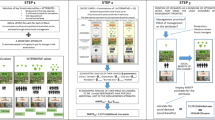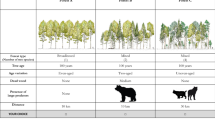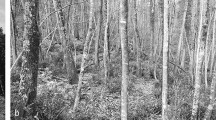Abstract
Forests produce benefits over and above the revenue yielded from timber and other wood based products. Most important among these may be the recreational benefits for visitors, which have been examined in several studies. Total benefits for residents are perhaps more accurately captured in property values since, ceteris paribus, the price of a house reflects willingness to pay to live near an environmental amenity such as a forest to gain access to it, and also the amenity (non-use) value of the forest in so far as it creates a pleasant landscape. However, the total non-priced value of forestry is not the sum of HPM and ITCM benefit estimates. Recreational benefits will typically be less, and will be subsumed in the HPM estimates, since the hedonic price is partly induced by the value of recreational access.
Similar content being viewed by others
References
AlonsoW. (1964). Location and Land Use: Toward a General Theory of Land Rent, Harvard University Press: Cambridge, MA.
AndersonL. M. and CordellH. K. (1988). ‘Influence of Trees on Residential Property Values in Athens, Georgia (U.S.A.): A Survey Based on Actual Sales Prices’, Landscape and Urban Planning 15, 153–164.
BalkanE. and KahnJ. R. (1988). ‘The Value of Changes in Deer Hunting Quality: A Travel-Cost Approach’, Applied Economic 20, 533–539.
Benson, J. F. and Willis, K. G. (1990). The Aggregate Value of the Non-Priced Recreation Benefits of the Forestry Commission Estate, Report to the Development Division, Forestry Commission, Edinburgh.
BrownW. G. and NawasF. (1973). ‘Impact of Aggregation on the Estimation of Outdoor Recreation Demand Functions’, American Journal of Agricultural Economics 53, 246–249.
BrownW. G., SorhusC., Chou-YangB., and RichardsJ. T. (1983). ‘Using Individual Observations to Estimate Recreation Demand Functions: A Caution’, American Journal of Agricultural Economics 65, 154–157.
CasselE. and MendelsohnR. (1985). ‘The Choice of Functional Forms for Hedonic Price Equations: Comment’, Journal of Urban Economics 18, 135–142.
CropperM. L., DeckL. B., and McConnellK. E. (1988). ‘On the Choice of Functional Forms for Hedonic Price Functions’, Review of Economics and Statistics 70, 668–675.
Department of Transport (1987). Values for Journey Time Savings and Accident Prevention, Department of Transport, London.
FollainJ. R. and JimenezE. (1985). ‘Estimating the Demand for Housing Characteristics’, Regional Science and Urban Economics 15, 77–107.
Forestry Commission (1989). 68th Annual Report and Accounts 1987–88, HMSO, London.
Garrod, G. D. and Allanson, P. F. (1991). ‘The Choice of Functional Form for Hedonic House Price Functions: A Review of Conflicting Evidence’, Countryside Change Initiative Working Paper, 23. Department of Agricultural Economics and Food Marketing, University of Newcastle upon Tyne.
GarrodG. D. and WillisK. G. (1992). ‘The Environmental Economic Impact of Woodland: A Two Stage Hedonic Price Model of the Amenity Value of Forestry in Britain’, Applied Economics 24, 715–728.
GravesP., MurdochD. C., ThayerM. A., and WaldmanD. (1988). ‘The Robustness of Hedonic Price Estimation: Urban Air Quality’, Land Economics 64, 220–233.
House of Commons' Committee of Public Accounts (1987). Forestry Commission: Review of Objectives and Achievements, Twelfth Report of the Committee of Public Accounts for the Session 1986–87, HMSO, London.
JudG. D. and WattsJ. M. (1981). ‘Schools and Housing Values’, Land Economics 57, 459–470.
KlingC. L. (1987). ‘A Simulation Approach to Comparing Multiple Site Recreation Demand Models Using Chesapeake Bay Survey Data’, Marine Resource Economics 4, 95–109.
KlingC. L. (1988). ‘Comparing Welfare Estimates of Environmental Quality Changes from Recreation Demand Models’, Journal of Environmental Economics and Management 15, 331–340.
LancasterK. J. (1966). ‘A New Approach to Consumer Theory’, Journal of Political Economy 74, 132–157.
LinnemanP. (1980). ‘Some Empirical Results on the Nature of the Hedonic Price Function for the Urban Housing Market’, Journal of Urban Economics 8, 47–68.
McConnellK. E. (1985). ‘The Economics of Outdoor Recreation’, in A. V.Kneese and J. L.Sweeney, eds., Handbook of Natural Resource and Energy Economics, North Holland, Amsterdam: Elsevier Science Publishers Inc.
McConnellK. E. (1990). Double Counting in Hedonic and Travel Cost Methods’, Land Economics 66, 121–127.
MichaelsR. G. and SmithV. K. (1990). ‘Market Segmentation and Valuing Amenities with Hedonic Models: The Case of Hazardous Waste Sites’, Journal of Urban Economics 28, 23–242.
MoralesD. J. (1980). ‘The Contribution of Trees to Residential Property Value’, Journal of Arboriculture 6, 305–308.
MostellerF. and TukeyJ. W. (1977). Data Analysis and Regression, Addison-Wesley, Reading, MA.
NelsonJ. P. (1978). ‘Residential Choice, Hedonic Prices, and the Demand for Urban Air Quality’, Journal of Urban Economics 5, 357–369.
NicholsonM. and WillisK. G. (1991). ‘Cost and Benefits of Housing Subsidies to Tenants from Voluntary and Involuntary Rent Control: A Comparison between Tenures and Income Groups’, Applied Economics 23, 1103–1115.
RosenS. (1974). ‘Hedonic Prices and Implicit Markets: Product Differentiation in Pure Competition’, Journal of Political Economy 82, 34–55.
SellerC., StollJ. R., and ChavasJ. P. (1985). ‘Validation of Empirical Measures of Welfare Change: A Comparison of Non-Market Techniques’, Land Economics 61, 156–175.
SmithV. K. (1988). ‘Selection and Recreation Demand’, American Journal of Agricultural Economics 70, 29–36.
SmithV. K. and DesvousgesW. H. (1985). ‘The Generalised Travel-Cost Model and Water Quality Benefits: A Reconsideration’, Southern Economics Journal 52, 371–381.
Wabe, J. S. (1970). ‘A Study of House Prices as a Means of Establishing the Value of Journey Time, the Rate of Time Preference and the Valuation of Some Aspects of the Environment in the London Metropolitan Region’, Research Paper No. 11, Department of Economics, University of Warwick.
WillisK. G. and BensonJ. F. (1989). ‘Recreational Values of Forests’, Forestry 62, 93–110.
WillisK. G. and GarrodG. D. (1991). ‘An Individual Travel-Cost Method of Evaluating Forest Recreation’, Journal of Agricultural Economics 42, 33–42.
Author information
Authors and Affiliations
Rights and permissions
About this article
Cite this article
Garrod, G., Willis, K. The amenity value of woodland in Great Britain: A comparison of economic estimates. Environmental and Resource Economics 2, 415–434 (1992). https://doi.org/10.1007/BF00304970
Issue Date:
DOI: https://doi.org/10.1007/BF00304970




